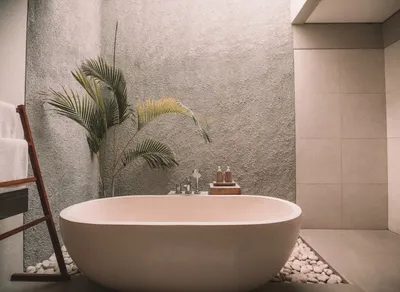For over long years, we have diligently conducted independent research and product testing. When you make a purchase through our links, we may earn a commission.
Create Your Oasis: Transform Your Home with Relaxing Home Decor
Created: 1 month ago

12 min Read
Transform your home into a serene oasis with our guide to relaxing home decor. Discover simple tips and ideas to create a peaceful retreat. Start designing your sanctuary today!
Creating a relaxing home environment is crucial for overall well-being and mental health. In today's fast-paced world, it is essential to have a space where you can unwind and recharge. By transforming your home into a serene oasis, you can escape the stresses of daily life and promote a sense of calm and tranquility. In this guide, we will explore the importance of a relaxing home environment and provide you with simple tips and ideas to achieve it. So, let's dive in and discover how you can turn your home into a peaceful retreat.
When it comes to creating a soothing ambiance in your home, choosing the right color palette is key. Colors have a powerful impact on our emotions and can greatly influence how we feel in a space. By selecting colors that evoke a sense of tranquility and relaxation, you can instantly transform your home into a serene oasis.
Pastel shades such as soft blue, pale green, and lavender are excellent choices for creating a calming atmosphere. These colors have a gentle and soothing effect on the mind and can help to promote a sense of peace and relaxation.
For those who prefer a more neutral color palette, earth tones like warm beige, soft brown, and creamy white are ideal. These natural hues evoke a sense of grounding and stability, perfect for creating a tranquil environment.
If you're looking to add a touch of depth and drama to your space, consider incorporating rich, deep colors in small accents or focal points. Shades like deep navy, burgundy, or forest green can create a sense of coziness and luxury, adding an element of sophistication to your relaxing home decor.
In addition to the color on your walls, pay attention to the colors of your furnishings and accessories. Opt for fabrics and materials in soothing tones, and use accent pieces in complementary colors to add interest and visual harmony to your space.
Remember, the key is to create a harmonious color scheme that promotes relaxation. Experiment with different color combinations and see which ones resonate with your personal sense of tranquility. Your home should be a reflection of your unique style and a sanctuary for relaxation and rejuvenation.
When it comes to creating a soothing and relaxing home environment, one effective way to achieve this is by incorporating natural elements into your decor. Bringing the outdoors in not only adds a touch of beauty to your space but also helps to create a sense of connection with nature. Whether you have a green thumb or not, there are several simple ways to infuse natural elements into your home.
Plants are an excellent way to bring nature indoors and add a refreshing touch to any room. Not only do plants add visual appeal, but they also help to purify the air and improve indoor air quality. Consider adding a mix of leafy green plants such as ferns, spider plants, and pothos, as well as flowering plants like orchids or peace lilies. Place them strategically in different areas of your home to create a serene and lush atmosphere.
Don't have a green thumb? No worries! There are plenty of low-maintenance artificial plants available that look just as beautiful and realistic as real ones. Opt for high-quality silk or plastic plants that mimic the look and feel of natural foliage. This way, you can enjoy the benefits of greenery without the hassle of watering and maintaining live plants.
In addition to plants, natural materials can also be used to bring the outdoors in. Consider incorporating elements such as wood, stone, and wicker into your decor. These materials add a sense of warmth and texture, instantly creating a cozy and inviting atmosphere. Choose furniture pieces with natural wood finishes, incorporate stone accents, or add woven wicker baskets for storage.
Another way to bring the outdoors in is by utilizing natural lighting. Open up your curtains and let the natural sunlight flood in during the day. Natural light has a positive impact on our mood and can make any space feel brighter and more spacious. If privacy is a concern, consider installing sheer curtains or blinds that allow light to filter through while still providing some privacy.
Lastly, don't forget about natural scents. Consider using aromatherapy diffusers or candles with scents derived from essential oils. Scents like lavender, eucalyptus, and citrus can promote relaxation and create a spa-like ambiance in your home.
By incorporating natural elements into your home decor, you can create a serene oasis that brings the outdoors in. Whether it's through plants, natural materials, lighting, or scents, each element plays a significant role in creating a peaceful and relaxing atmosphere. So go ahead, embrace nature and transform your home into a tranquil sanctuary.
Creating a relaxing and comfortable home environment goes beyond just the colors and natural elements. It also involves choosing the right furniture and textiles that promote optimal comfort. The keyword, optimal comfort, is crucial when it comes to selecting the right pieces for your space. Let's explore some key factors to consider when choosing furniture and textiles to enhance the comfort of your home.
Furniture: The furniture you choose can have a significant impact on the overall comfort of your space. Look for pieces that prioritize comfort and functionality. Consider investing in a comfortable sofa or sectional with plush cushions and ample seating space. Opt for chairs and ottomans that provide proper support for your body, allowing you to lounge and relax without any discomfort. When selecting a bed or mattress, prioritize comfort and support to ensure a restful night's sleep.
Textiles: The textiles you incorporate into your home can add an extra layer of comfort and coziness. Soft, plush materials such as velvet, chenille, or faux fur can make your seating and bedding feel luxurious and inviting. Use these textiles in the form of throws, pillows, and rugs to add warmth and texture to your space. Consider using organic and natural fabrics like cotton, linen, or bamboo for your bedding and curtains. These materials are breathable, hypoallergenic, and gentle on the skin, promoting a comfortable and restful environment.
In addition to comfort, it's essential to consider the durability of your furniture and textiles. Opt for high-quality pieces that are designed to withstand everyday use and wear. Look for furniture with sturdy frames and durable upholstery fabrics. When it comes to textiles, choose materials that are easy to clean and maintain, especially in high-traffic areas or if you have children or pets.
Another factor to consider is ergonomics. Ergonomic furniture and textiles are designed to support the natural posture and movements of the body, reducing the risk of discomfort or strain. Look for chairs with proper lumbar support and adjustable features to promote good posture. Pay attention to mattress firmness and support to ensure a healthy sleep environment.
Lastly, don't forget about personal preference. While considering comfort, durability, and ergonomics, choose furniture and textiles that align with your unique style and taste. Your home should be a reflection of your personality and a place where you feel most comfortable and at ease.
In summary, selecting the right furniture and textiles plays a crucial role in creating a comfortable and relaxing home environment. Prioritize comfort, functionality, durability, and ergonomics when choosing your pieces. Don't be afraid to incorporate soft, plush textiles and organic fabrics to add an extra layer of comfort and coziness. Remember to consider your personal preferences and create a space that truly feels like a sanctuary of comfort and relaxation.
Declutter and Simplify: Clearing the Space for a Peaceful Mindset
Living in a cluttered and disorganized space can have a negative impact on our mental well-being. The keyword here is declutter and simplify. When our surroundings are filled with unnecessary items and chaos, it can be challenging to find a sense of peace and tranquility. However, by taking the time to declutter and simplify our homes, we can create a space that promotes a peaceful mindset.
Decluttering is the process of removing excess items from our living spaces, while simplifying is about streamlining and organizing what's left. Let's explore some practical tips and strategies to help you declutter and simplify your home.
Start Small, One Space at a Time
Clutter can be overwhelming, so it's important to start small and take it one space at a time. Choose a specific area, such as a closet, a drawer, or a countertop, to begin your decluttering journey. This approach allows you to focus your energy and see progress, which can motivate you to continue.
The Three-Box Technique
To effectively declutter, use the three-box technique. Label three boxes or bins as "Keep," "Donate/Sell," and "Trash." As you go through your belongings, decide which items you want to keep, which ones you can donate or sell, and which ones are no longer usable and should be thrown away. Be honest with yourself and let go of items that no longer serve a purpose or bring you joy.
Create a Clutter-Free Zone
Designate a specific area in your home as a clutter-free zone. This can be a peaceful corner in your bedroom, a quiet reading nook, or a serene workspace. Keep this area free from clutter and distractions, focusing on simplicity and minimalism. Having a clutter-free zone allows you to have a dedicated space for relaxation and reflection.
Embrace Minimalism
Embracing a minimalistic approach to home decor and possessions can contribute to a peaceful mindset. The concept of minimalism revolves around living with intention and having only what is essential. It's about quality over quantity. Consider what truly adds value to your life and let go of unnecessary excess. Simplify your belongings, focusing on items that bring you joy and serve a purpose.
Organize and Streamline
Once you've decluttered, it's crucial to organize and streamline what's left. Use storage solutions such as bins, baskets, and trays to keep things in order. Label containers and shelves to make it easy to find items when needed. Optimize your space by arranging belongings in a way that is visually appealing and functional.
Adopt a "One In, One Out" Rule
To maintain a clutter-free and peaceful home, adopt the "one in, one out" rule. This means that for every new item you bring into your home, you must let go of an existing item. By practicing this rule, you prevent clutter from accumulating over time and ensure that your space remains organized and simplified.
Enjoy the Benefits
The process of decluttering and simplifying your home may require time and effort, but the benefits are well worth it. A clutter-free and simplified space allows for better focus, reduced stress, and a greater sense of calm. It becomes easier to find things, maintain cleanliness, and create a serene environment that supports your overall well-being.
By decluttering and simplifying your home, you are not only creating a physical space but also clearing the space for a peaceful mindset. Embrace the journey of letting go, organizing, and streamlining your belongings. Remember, decluttering is not a one-time event but an ongoing process. Regularly assess your space and make adjustments as needed to maintain a harmonious and peaceful home.
Lighting plays a crucial role in creating the overall ambiance of a space. When it comes to achieving a soft, ambient lighting effect in your home, there are several factors to consider. Let's explore some tips and techniques to help you create the perfect lighting atmosphere.
Natural light is a wonderful starting point for achieving soft, ambient lighting. During the day, try to maximize the amount of natural light entering your space. Keep curtains and blinds open to let the sunlight in, creating a warm and inviting atmosphere.
In addition to natural light, layered lighting can help you achieve a soft, ambient effect. This involves combining different types of lighting sources to create a balanced and visually appealing look.
Overhead lighting is the foundation of a well-lit room. Consider using chandeliers or pendant lights with dimmable features to adjust the intensity of the light. This allows you to control the mood and create a softer ambiance when desired.
Task lighting, such as table lamps or floor lamps, can provide focused illumination in specific areas. Use these types of lights to create cozy reading nooks or illuminate workspaces. Pair them with adjustable shades or bulbs with dimmer switches to customize the amount of light and create a soothing environment.
Accent lighting is another technique to add dimension and create a soft glow. Use wall sconces or spotlights to highlight artwork, architectural features, or decorative elements in your space. This type of lighting adds a touch of elegance and creates a warm ambiance.
To achieve a softer, more diffused lighting effect, consider using lampshades or fabric diffusers. These options help to soften the intensity of the light source and create a gentle, ambient glow.
Another important factor to consider is the color temperature of your light bulbs. Warm white or soft white bulbs create a cozy and welcoming atmosphere. Avoid using cool white or daylight bulbs, as they can create a harsh and sterile feel.
When positioning your light sources, aim for indirect lighting. This involves bouncing the light off surfaces such as walls or ceilings, which helps to create a softer and more even distribution of light.
Using downlights or recessed lighting with adjustable trims can provide a subtle, indirect lighting effect. You can also try wall-mounted fixtures that direct the light upward, casting a warm glow on the ceiling and walls.
In terms of light fixtures, shades that diffuse the light or have textured materials can help to create a softer and more gentle lighting effect. Experiment with different shapes and materials to find the perfect balance between functionality and aesthetics.
Don't forget about candles for creating soft, ambient lighting. Place them strategically around your space to add a warm and cozy glow. Be sure to follow safety precautions and use flameless candles if you prefer a safer option.
In summary, achieving soft, ambient lighting in your home involves a combination of factors, including maximizing natural light, layering different lighting sources, using adjustable features, and paying attention to color temperature. By considering these tips and techniques, you can create a soothing and inviting atmosphere that promotes relaxation and comfort.




















